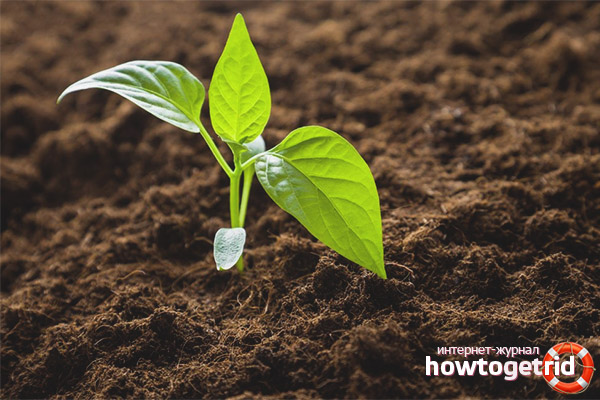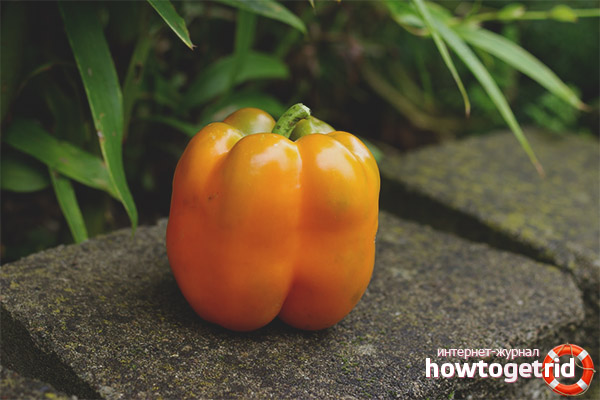The content of the article
The ripe fruit has a bright orange color. This variety has become popular in part due to its high taste. The pulp of the pepper is quite dense and soft, the wall thickness reaches 0.8 cm. With proper agricultural technology, up to three kilograms of the product can be collected from one bush. In the fruits of pepper Orange Miracle, a large number of carotenoids accumulate, including carotene and lycopene.
Grade description
Pepper Orange miracle belongs to early ripe varieties, as a rule, harvesting can be done 110 days after planting in open ground. The plant does not exceed 150 cm in height. Under favorable climatic conditions and proper care, the fruits reach 250 g, the shape of the pepper is cuboid. Pepper is resistant to apical rot, has good preservation after a break from the bush.
The undoubted advantage of this variety is that it can be either consumed fresh or canned, and, if desired, it can be stuffed. The variety is resistant to most diseases and pests.
Seed preparation
It is quite possible to grow both indoors and outdoors. As a rule, this culture is grown by seedlings, and for this it is necessary to grow it. But before growing, you need to purchase quality seeds in trusted stores. First, select the seeds. To do this, they must be filled with a glass of water.
Those that come up can be considered marriage. After that, it is necessary to carry out the hardening procedure in a non-concentrated solution of potassium permanganate. This will help prevent future fungal infections. At the end of this procedure, the seeds should be placed on wet gauze and left for a couple of hours until the seeds swell.
An important point is the preparation of the soil for growing seedlings. Remember that bell pepper does not tolerate acidic soils, so choose a soil with a pH of about 7. You can prepare the soil mixture yourself from chernozem, rotted leaves, peat and a small amount of coarse river sand.
Growing seedlings
You can get high-quality planting material even in a city apartment.
To grow seedlings of sweet pepper Orange Miracle begins 60 days before the expected date of planting in open ground or greenhouses. To grow high-quality planting material, the first thing you need to do is select seeds. All grains are poured with a small amount of water. Those seeds that have surfaced are defective.
After the seeds must be planted in small peat pots. Planting seeds of bell pepper is recommended in small peat containers. Large containers for seedlings are undesirable; pepper has a slowly developing root system.
Planting seeds is not too deep, as this can slow down the germination of pepper. Place the seed container in a warm place and cover with glass or plastic wrap. In early spring, bell pepper seedlings do not have enough solar energy; plants need additional lighting in the evening and in the morning.
It is advisable to grow pepper seedlings in small pots, since the root system is slowly developing. If the cultivation of this culture will be carried out in the open field, then about two weeks before planting, the seedlings should be taken out to the street for hardening. At the punching stage, the light is not needed, and as soon as the first loops of shoots appear, transfer the container with shoots closer to the light.
The optimum temperature for the germination of pepper seeds is 22-24 degrees.Do not forget that pepper is a thermophilic culture that does not tolerate drafts and lower temperatures below 10 degrees. Water the seedlings only with warm water through a strainer or spray bottle.
The procedure for diving sweet pepper is required. Seedlings dive at the age of 3-4 weeks. Do not leave seedlings to grow in one pot.
Variety Orange miracle does not tolerate transplant. You need to get the plant out of the pot very carefully with a lump of earth.
One of the common mistakes of beginning gardeners is a rush to sow seeds. Do not rush to plant a heat-loving culture.
The optimum sowing date is mid-March. In addition, in February, daylight hours are not long enough, seedlings will be frail, yellow, painful and elongated. Such plants will never bring a good harvest. If you still decided to grow pepper in February, take care of the additional lighting of seedlings with special lamps.
This culture does not tolerate drafts and short-term temperature drops of up to 8-10 degrees. Additional lighting is the key to getting good seedlings.
The first dressing of seedlings is carried out 2-3 weeks after emergence, for this use solutions of urea, ammonium nitrate and complex fertilizers.
Crops should not be thickened, otherwise the plants will begin to compete for light, water and nutrients. Seedlings with thickened cultivation will turn out to be unviable, elongated.
Landing

Nitroammophoska, some wood ash, humus are added to the planting pits. After planting, seedlings are abundantly watered with warm water under the root. On one square meter, place 2-3 bushes.
After planting, shade the seedlings with a non-woven covering material. It will protect young fragile bushes from the wind and the scorching rays of the sun. Do not rush into fertilizing. The first top dressing can be done when the seedlings take root, 2 weeks after planting.
Care
You can plant bell pepper in open ground at the end of May, when the weather is warm. This culture is thermophilic, does not tolerate low temperatures. If the seedlings were exposed to low positive temperatures, the plant will not bring a good harvest in the future.
An important component of care is watering. Pepper does not tolerate drought, but also does not favor excess water. Watering is carried out directly under the root, otherwise there is a risk of sunburn. Excess water can lead to fungal diseases, as well as to decay of the plant.
Pepper is preferable to grow on noble soils. Otherwise, regular application of complex fertilizers will be required. If the soil is fertile, then three times more fertilizing will be sufficient.
The soil under the bushes is mulched with mowed grass, straw or sawdust. The layer of mulch retains moisture in the surface layers of the soil, favorably affects the growth and development of the plant.
During the flowering period, bell pepper in plentiful watering, fertilizing with potash fertilizers.
Do not forget to timely loosen the soil and remove weeds. During harvesting, watering should be moderate. If transportation over long distances is planned, then the fruits must be harvested in a state of technical maturity.
Video: orange pepper miracle










Submit